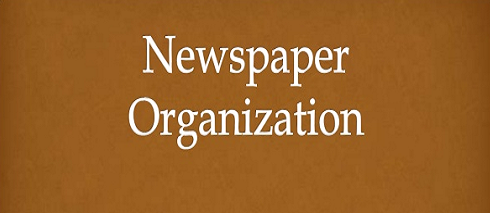NEWSPAPER ORGANIZATION
In order to operate a newspaper effectively like any other organization, it must be organized in a systematic way. The departmental structure and staffing of a newspaper vary with its size. All newspapers, however, have certain common structure. Head of newspaper organization is called Editor-in-Chief or Chief Editor. Under the head, two main departments work :1. News Section
2. Management & Services Department
1. NEWS SECTION :
This section deals with things printed in newspapers. It covers all spheres of journalism. News section broadly divided into two fields:
i. Editorial Board
ii. Editor
i. Editorial Board :
Editorial board is the main pillar of a newspaper organization. It elaborates the paper’s policy. Journalists who work in this section, write editorials about an issue. Number of editors vary according to the size of a newspaper. Big organizations have almost twelve-thirteen editors working in editorial board.
ii. Editor :
Head of news section is called Chief News Editor. His important role is to select the matter would be printed in a newspaper. Following are the sections worked under Chief News Editor.
a. Newsroom :
We can rightly called newsroom as backbone of a newspaper. Getting out a newspaper is a 24-hour a day job. Events are happened at all hours and many stories come unexpectedly. Not only that, news is perishable, it becomes less valuable as it ages. Trying to cope with the never ending flow of news and the constant pressure to keep it fresh requires organization and coordination among the paper’s staff. An event becomes news in newsroom by passing through different stages. Sub-editors prepare news by polishing an event.
b. Reporting Section :
Chief Reporter heads all other reporters. In reporting section, reporters compile their field work in news form. Chief reporter prepares duty chart for all reporters. He assigns beats to his subordinates.
c. Photographic Section :
Pictures have great importance to communicate a message. All big newspaper groups have established photographic section. Many photographers are engaged to perform their duties. Every important news is visualized by using photographs.
d. Magazine Section:
Magazine Section is related with Sunday magazine and daily special editions.
Magazine Editor is responsible for editions. Following features are the speciality of
editions:
1. Copy Editors :
Copy editors work in magazine section. Their duty is to arrange different pages of a newspaper. Sub-editors are worked under copy editors.
2. Edition Incharge :
Edition Incharge of different editions like political, children, women, showbiz and sports are assigned. Edition Incharge is responsible to prepare his/her own edition.
2. MANAGEMENT & SERVICE DEPARTMENT :
The head of Management & Services Department is called general manager. He supervises the management of an organization. Different sections are worked under this department:
i. Administrator :
Administrator is a head over this department. Under group general manager, all other sections like Personnel Section, Accounts Sections, Procurement Section, Store Section and Reference Section are worked.
ii. Production :
Newspaper production task is accomplished in three phases. The first phase occurs in the composing room or composing section where the page is laid out, the second phase occurs in the. Plate Making Section, where the plates that produce the printed page are prepared, and the last phase occurs in the Press Room, where the paper is actually printed on high speed presses.
Computers, offset printers and lasers have all combined to increase the speed and efficiency of newspaper production.
i. Business Manager :
Business manager is the incharge of economics of a newspaper. The newspapers business office operates pretty much like any other business office. The newspaper’s business department performs advertising, circulation and promotion functions. It has major divisions, an advertising department, a circulation department, a promotion department and an accounting or auditing department.
Newspaper Economics :
Newspapers derive their income from two sources:
(1) Advertising Section
(2) Circulation Section
(1) Advertising Section :
Advertising provides 75 to 80 percent of the total revenue. This revenue is closely related to circulation since papers with a large circulation are able to charge more for ads that will reach a large audience. Advertising revenue comes from four separate sources:
i. National and governmental advertising.
ii. Local advertising.
iii. Classified advertising.
iv. Preprinted inserts.
Local retail advertising is the most important source of newspaper’s income, accounting for about 50 percent of all revenue. Classified ads come next with 40 percent, followed by national ads and preprinted inserts. In most countries, newspaper industry cannot Stand
without government ads. Government ads are major source of income.
(2) Circulation Section :
Revenue comes from subscriptions and single copy sales, that accounts for other 20 to 25 percent of total revenue. Circulation revenue includes all the receipts from selling the paper to the. consumer. The newspaper, however, does not receive the total price paid by a reader for a copy of the paper because of the many distribution systems that are employed to get the newspaper to the consumer. Circulation manager maintains the circulation records for city and area publications. He is also incharge of moving the papers into the appropriate distribution channels as they move into the mailing room from the press. He also supervises the sales promotion department.










1 Comments